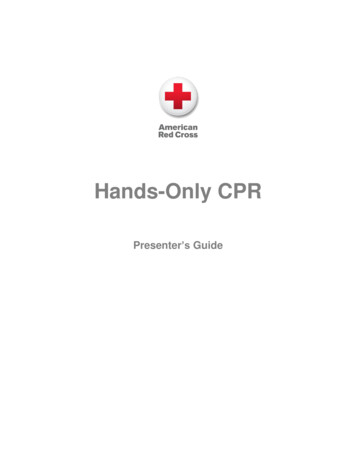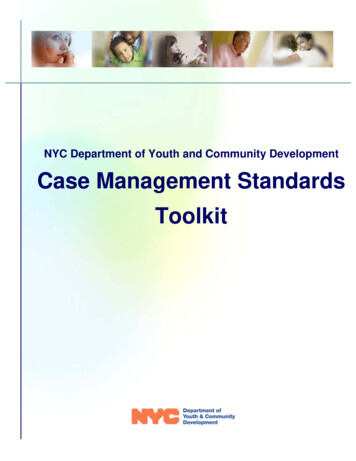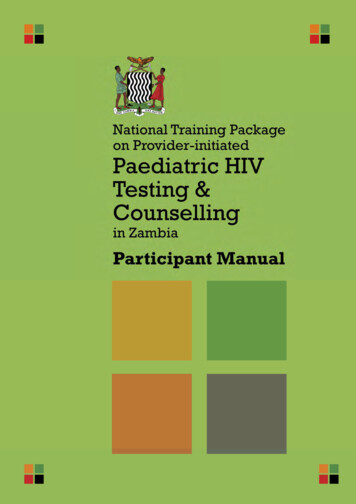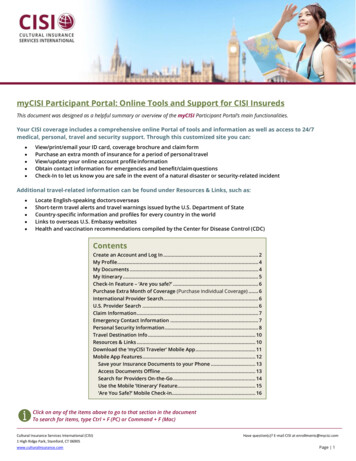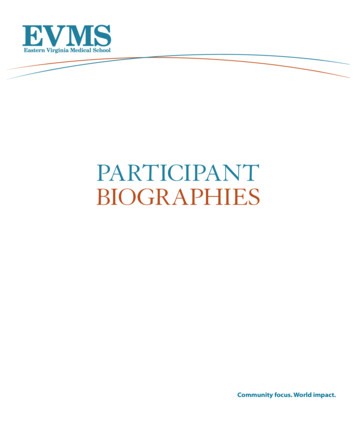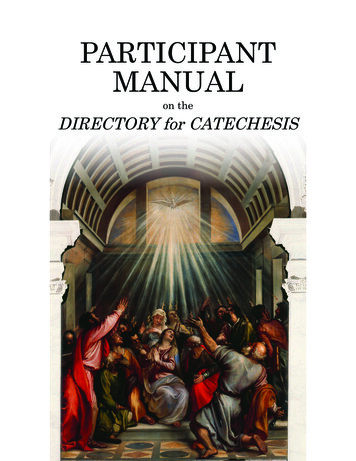
Transcription
PARTICIPANTMANUALon theDIRECTORY for CATECHESIS
vCatechesis makes the proclamationof the passion, death and resurrection of Jesus Christcontinually resound in the heart of every person,so that life may be transformed.A dynamic and complex reality at the service of the Word of God,catechesis is accompaniment, education and formationin the faith and for the faith,an introduction to the celebration of the Mystery,illumination and interpretation of human life and history.By harmoniously integrating these characteristics,catechesis expresses the richness of its essence and offers itsspecific contribution to the pastoral mission of the Church.Directory for Catechesis, 55.vCommittee on Evangelization and CatechesisUnited States Conference of Catholic BishopsQuotes from the Directory for Catechesis, copyright 2020, Libreria Editrice Vaticana, Vatican City State. Used with permission. All rights reserved.Excerpts from the English translation of the Catechism of the Catholic Church Second ed.for use in the United States of America Copyright 2000,United States Catholic Conference, Inc. -- Libreria Editrice Vaticana. Used with Permission.Cover Photo: Pentecost (Descent of the Holy Ghost), Titian. Cameraphoto Arte, Venice / Art Resource, NYCopyright 2021, United States Conference of Catholic Bishops, Washington, DC. All rights reserved.2
CONTENTS“How To Use” the Participant ManualUnit 1: IntroductionWelcome and general overview of the Directory for Catechesis; History, purpose,major parts and overarching framework of the Directory for Catechesis.Unit 2: Chapters I and IIRevelation and Its Transmission; Identity of Catechesis.Unit 3: Chapters III and IVThe Vocation and Formation of Catechists.Unit 4: Chapters V, VI, and VIIPedagogy of Faith; The Catechism of the Catholic Church; CatecheticalMethodology.Unit 5: Chapters VIII and IXCatechesis in the Lives of Persons; Catechesis in the Christian Community.Unit 6: Chapters X, XI, and XIICatechesis in Contemporary Cultural Scenarios; Inculturation of Faith; Thosein the Church who serve catechesis.Unit 7: Summary of major themes and reflectionGlossary of select terms3
OVERVIEW OF PARTICIPANT MANUAL UNIT THEMES Unit 1: Overview of the Directory for CatechesisPreface and Introduction to the Directory for Catechesis. Unit 2: Chapters I and IIRevelation and Its Transmission; Identity of Catechesis. Unit 3: Chapters III and IVThe Vocation and Formation of Catechists. Unit 4: Chapters V, VI, and VIIPedagogy of Faith; The Catechism of the Catholic Church; CatecheticalMethodology. Unit 5: Chapters VIII and IXCatechesis in the Lives of Persons; Catechesis in the Christian Community. Unit 6: Chapters X, XI, and XIICatechesis in Contemporary Cultural Scenarios; Inculturation of Faith; Thosein the Church who serve catechesis. Unit 7: Summary and reflection on the Directory for CatechesisOPENING PRAYER - Prayer to the Holy SpiritCome, Holy Spirit, fill the hearts of your faithful.And kindle in them the fire of your love.Send forth your Spirit and they shall be created.And you will renew the face of the earth.Lord, by the light of the Holy Spirityou have taught the hearts of your faithful.In the same Spirit help us to relish what is rightand always rejoice in your consolation.We ask this through Christ our Lord. Amen.The English translation of the Prayer to the Holy Spirit from A Book of Prayers 1982, International Committee on English in theLiturgy, Inc. (ICEL). All rights reserved.4
“HOW TO USE” THE PARTICIPANT MANUAL to theDIRECTORY FOR CATECHESIS:v Thank you for responding to the call v The Holy Spirit is the soul of theto catechetical ministry. Your vocationevangelizing Church, notes theas a catechist will be enriched andDirectory for Catechesis. Every discusstrengthened as you break open thesion session begins with a Prayerriches of the Directory for Catechesis.to the Holy Spirit and includesPrayer, study, and group discussionmoments of silent reflection on thewill deepen your understanding ofWord of God, common prayers ofthe identity, nature, tasks, and sourcesintercession and suitable hymns. Eachof catechesis as it comes to life in yoursession concludes with the Wordcatechetical ministry in service of theof God and prayers of thanksgivingcommunity of faith.and intercession for the needs of thecommunity.v This Participant Manual is a companion to, and not a substitute for, yourv In each unit of this Participantpersonal reading and group discusManual, you will find the following:sion on the Directory for Catechesis.ü Objectives that highlight the focusYou will get the most out of this comof each session.panion resource as you set aside timeü Overview of Key Themes to guideto read and reflect on the text of theyour reading and discussion.Directory for Catechesis and to becomeü Discussion Questions for use infamiliar with its overall vision, itssmall or large group discussions.themes and emphases, and its distinctü Journal Notes provides space forlanguage.you to record your reflections andresponses to discussion questions.JOURNAL NOTES – space for participant to record responses/insights:5
UNIT 1 – INTRODUCTIONOPENING PRAYER - Prayer to theHoly Spiritare missionary disciples who form catechists tobe missionary disciples who, in turn, invite others to a personal, living, and life-transformingencounter with Jesus Christ within the community of the Church.Come, Holy Spirit, fill the hearts of your faithful.And kindle in them the fire of your love.Send forth your Spirit and they shall be created.And you will renew the face of the earth.A catechist is a lifelong Christian disciple whoseeks to grow daily in knowledge and love ofthe Word of God with dedication to formingothers through personal witness to Jesus Christin the power of the Holy Spirit. This ParticipantManual embodies the priority given to catechistformation in the Directory for Catechesis, whichstates: “Formation sets as its goal, in the firstplace, making catechists aware that as baptizedpersons they are true missionary disciples, meaning active participants in evangelization, and onthis basis are enabled by the Church to communicate the Gospel and to accompany and educatebelievers in the faith” (DC 132).Lord, by the light of the Holy Spirityou have taught the hearts of your faithful.In the same Spirit help us to relish what is rightand always rejoice in your consolation.We ask this through Christ our Lord. Amen.The English translation of the Prayer to the Holy Spirit from A Book ofPrayers 1982, International Committee on English in the Liturgy, Inc.(ICEL). All rights reserved.Welcome to the Participant Manual to theDirectory for CatechesisThe Participant Manual you hold in your handis a companion resource to the Directory forCatechesis published by the Pontifical Councilfor the Promotion of the New Evangelizationin June 2020. Like any guide, this resourceis offered as a roadmap or a trusted tool. Itis meant as an informative and instructiveguide, not a substitute, for your own readingand prayerful reflection on the Directory forCatechesis. It aims to prepare you to discover thetremendous gift and responsibility of catechetical ministry in the Church. What a privilege itis to participate in the Church’s age-old ministry of catechesis centered on the invitation toaccept the Good News of Jesus’ life, death, andresurrection, by which God reconciles us toHimself, enabling our friendship with Him inthe power of the Holy Spirit.The Directory for Catechesis notes that catechistformation involves being a catechist before actingas a catechist. Dimensions of catechist formation are identified as such: being and “knowing-how to be with” others, biblical-theologicalformation, understanding human beings andtheir social context, and pedagogical and methodological formation. This Participant Manualis one tool for the formation of catecheticalleaders and catechists that reflects the prioritygiven to initial and ongoing catechist formationin the Directory for Catechesis.The renewal of catechesis in every age isentrusted to bishops, pastors, and lay men andwomen who answer the call to serve all members of the faith community through the varioustasks, phases, and moments of catechesis. Asa catechetical leader, you have answered thecall to the privileged task of leading the dedicated catechists serving your community to arenewed understanding and living out of theirvocation as catechists. The renewal of your faithThis Participant Manual is more than a textbook or manual. The goal of this resource isto invigorate catechetical ministry by the lightof the Holy Spirit, soul of the evangelizingChurch, by preparing catechetical leaders who6
community depends on revitalized, vibrantministries of evangelization and catechesis thatbuild up and strengthen the community of theChurch that “exists in a permanent state ofmission.” With this in mind, this ParticipantManual is offered to assist you in study, reflection, and group discussion on the Directory forCatechesis.pastors. Thus they will be provided with certainmethods which will help them to dischargetheir own pastoral office with greater ease andeffectiveness. There should be prepared also aparticular directory concerning the pastoral careof special groups of the faithful as the differentcircumstances of individual nations or regionsrequire” (Christus Dominus, 44).OBJECTIVES:The first document in response to this call ofthe Second Vatican Council was the GeneralCatechetical Directory, approved by Saint PaulVI and published in March 1971. Followingthe publication of the Catechism of the CatholicChurch in 1992, a second document was presented in the General Directory for Catechesis,approved by Saint John Paul II and published inAugust 1997. The 2020 Directory for Catechesis,the third of its kind, stands in dynamic continuity with the two catechetical directories thatpreceded it. Its vision and themes are framedby the 2012 Synod on The New Evangelizationfor the Transmission of the Christian Faith andthe Apostolic Exhortation Evangelii Gaudiumof Pope Francis, who approved the Directory forCatechesis on March 23, 2020, for subsequentpublication on June 24, 2020, by the PontificalCouncil for the Promotion of the NewEvangelization. Understand the history of the Directory forCatechesis; Understand the purpose of the Directoryfor Catechesis, as explored in the Prefaceand Introduction; Understand the overarching framework ofthe Directory for Catechesis; and Reflect on challenges particular to catechesis, as outlined in the presentationthat accompanied the publication of theDirectory for Catechesis.History of the Directory for Catechesis:The Preface to the Directory for Catechesis outlines the history of this catechetical documentthat begins with the event of the SecondVatican Council. Saint Pope John Paul IInoted that the event and the documents of theSecond Vatican Council are “a gift of the Spiritto His Church,” a “great grace bestowed onthe Church in the 20th century,” and a “surecompass by which to take our bearings in thecentury now beginning.”As you take time to read the history of theDirectory for Catechesis in the Preface andIntroduction, you will see that this catecheticaldocument is written in dynamic continuitywith the two catechetical directories that camebefore it. Catechetical leaders, catechists, andevangelists will discover in this third catechetical directory the entire wealth of the Church’steachings on evangelization and catechesis sincethe Second Vatican Council.The genre of a catechetical directory in whichthe Church presents theological and pastoralprinciples regarding the nature, purpose, andtasks of catechesis emerged from the SecondVatican Council’s Decree on the Pastoral Officeof Bishops. In that conciliar document, theCouncil Fathers expressed the desire that“general directories be prepared treating of thecare of souls for the use of both bishops andPurpose of the Directory for Catechesis:The Directory for Catechesis from the PontificalCouncil for the Promotion of the NewEvangelization arrived at a timely moment in7
June 2020 as Christians everywhere struggledthrough a pandemic-ridden world. Two papalphrases frame the text – “The Church exists toevangelize,” of Saint Paul VI, and “I am a mission,” of Pope Francis.with disabilities, migrants, and prisoners.The presentation of a new Directory for Catechesison June 24, 2020 occurred three months afterits approval on March 23, 2020, the liturgicalmemorial of 16th century Saint Turibius ofMogrovejo, bishop and model catechist. Inthe intervening months between its approvaland its publication, Catholics across the universal Church endured the unprecedentedand devastating effects of a global pandemic.As the Church seeks to meet the spiritual andtemporal needs of a post-pandemic world, thisDirectory for Catechesis is a providential guide toa renewed proclamation of the Gospel of JesusChrist unfolding in the new evangelization andin that one remarkable dimension within it,that is, the ministry of catechesis.The central purpose of the Directory forCatechesis is to present fundamental theological-pastoral principles of the ministry of theWord, that is, catechesis, while responding tocurrent historical contexts, social conditions,and the cultural forces that shape the Church’scommunication of the living mystery of Godtoday (Introduction, 10). Addressed primarily tothose engaged in catechetical ministry, namely,bishops, pastors, catechists, parents, and teachers, this catechetical document invites the faithful on a journey of reflection on the nature,tasks, sources, contexts, content, and methodsof catechesis in the contemporary world. As adocument of the universal Church, it encourages the drafting or revision of national directories that attend to local catechetical opportunities and challenges in particular churches.Overarching framework and major parts of theDirectory for Catechesis:In a perfect synthesis of old and new elements,the Directory confirms the close link betweenevangelization and catechesis that unites theChurch’s faithful and joyful witness to theGospel core, the kerygma, to ongoing formation,education, and maturation of living faith withina community of believers.In three major parts divided across twelvechapters, the Directory for Catechesis highlightskey elements that permeate all catecheticalactivities: witness, mercy, and dialogue. Thetext affirms the age-old, perennial nature andpurpose of catechesis and highlights the vocation and formation of catechists. Several newemphases are also proposed: the primacy of thekerygma in all catechetical activities; the dynamicprocess of evangelization, and catechesis withinit, as a spiritual action above all; the baptismalcatechumenate as inspiration for all catecheticalactivities; the pedagogy of God that inspires thepedagogy of the Church in catechetical tasks ofinitiation, education, and ongoing formation inChristian discipleship; inculturation of catechesis; catechesis in, with, and of the family; catechesis in a digital culture, the globalization ofculture; bioethical issues that impact catechesis,the “way of beauty” in catechesis; and catechesisthat accompanies, with mercy, the poor, personsAs the Introduction notes, the criterion thatguided the writing of the Directory for Catechesisis “the desire to explore the role of catechesisin the dynamic of evangelization” (DC 5).The Preface and the Introduction highlightthe evangelizing mission of the Church as theoverarching framework for all forms and stagesof an evangelizing catechesis. Following PopeFrancis’ teaching in Evangelii Gaudium on thedistinctive characteristics of catechesis set withina missionary perspective, the Directory connectscatechesis more clearly and directly to the evangelizing proclamation of the Gospel to adults,youth and young adults, and children today.In the words of Pope Francis: “we have rediscovered the fundamental role of the first8
announcement or kerygma, which needs to bethe center of all evangelizing activities and allefforts at church renewal this first proclamation is called ‘first’ not because it exists atthe beginning and can then be forgotten orreplaced by other more important things. It isfirst in a qualitative sense because it is the principal proclamation, the one we must hear againand again in different ways, the one we mustannounce one way or another throughout theprocess of catechesis, at every level and moment All Christian formation consists of enteringmore deeply into the kerygma, which is reflectedin and constantly illumines, the work of catechesis (I)t is the message capable of responding to the desire for the infinite which abidesin every human heart” (Evangelii Gaudium, 164– 165).a Person, the Person of Jesus of Nazareth,”wrote Saint John Paul II (Catechesi Tradendae,5). At the center of the Directory for Catechesisstands the Person of Jesus Christ, whose incarnation, life, death, and resurrection groundsthe context, the content, and the methods ofa kerygmatic catechesis of children, youth, youngadults, and adults in the midst of contemporaryculture.The three major parts of the Directory forCatechesis “develop the catechetical journeyunder the primacy of evangelization.” Part Oneframes catechesis within the Church’s missionof evangelization. Part Two focuses on the identity, tasks, sources, inculturation, and process ofcatechesis, the pedagogy of God which inspiresthe pedagogy of the Church, the Catechism ofthe Catholic Church, and catechesis in the lives ofpersons and groups such as the family, children,youth, young adults, adults, the elderly, personswith disabilities, migrants, and prisoners. PartThree reflects on catechesis in the concreteexpressions of ecclesial life across cultures,ecclesial traditions, geographical settings, andthe opportunities and challenges posed by aglobalized digital culture and various currentbioethical issues. The Directory concludes by presenting organizations at the service of catechesis(Introduction 7-10).In the words of the Directory for Catechesis, “theprimacy of the kerygma, to the point of leadingus to propose a kergymatic catechesis, does notdistract at all from the value of mystagogy orfrom the witness of charity . Proclaiming theGospel is witnessing to an encounter that keepsthe focus on Jesus Christ, the Son of God,incarnate in the history of humanity, in orderto bring to fulfillment the revelation of theFather’s saving love” (Preface).Kerygmatic catechesis, that is, the proclamationand lived witness to the kerygma in all catechetical activities, is nothing less than the loving,joyful sharing of the Good News of the incarnation, life, death, and resurrection of JesusChrist as an invitation to live a transformed lifeof Christian faith within the community of theChurch. As the Introduction notes, catechesisaccompanies a dynamic process of internalization of the Gospel involving the whole personin his or her life experience in light of themystery of God’s revelation in Jesus Christ, aspiritual action that is the original and necessary form of inculturation of the faith.Pastoral mindsets that impede catecheticalministry today:The Directory for Catechesis was presented tothe universal Church at a press conference atthe Vatican on June 24, 2020. During thatpress conference, Archbishop Rino Fisichella,President of the Pontifical Council for thePromotion of the New Evangelization, presented an overview of the current needs of theChurch that gave birth to an updated catechetical directory. He spoke of the globalization ofculture, the phenomenon of digital culture, the“way of beauty” in catechesis, and other pastoralneeds and opportunities for catechesis carried“At the heart of catechesis we find, in essence,9
DISCUSSION QUESTIONS:out within the evangelizing mission of theChurch.1. Share one insight gained from your readingof the historical background to the Directory forCatechesis (Preface).Archbishop Fisichella noted three pastoralmindsets that require a “pastoral conversion”to free catechesis from certain barriers thatobstruct its effectiveness. First, the “schoolmodel” that reduces the ministry and tasks ofcatechesis to the school room, school calendar year, and school instruction by a teacher.Second, the tendency to reduce catechesis toa condition for reception of a particular sacrament of initiation without care for ongoingformation in a sacramental way of life onceinitiation is complete. Third, a mindset thatoverlooks a comprehensive and consistentliturgical catechesis on the sacraments of initiation for fear of losing youth who are required toparticipate in sacramental preparation programsfor completion of sacramental initiation.2. What does it mean to engage in kergymatic catechesis in all forms and at all stages of catechetical activity? Share particular topics that are ofinterest and relevance to your catechetical ministry in light of the overview of themes in theparts and chapters of the Directory for Catechesis.3. In light of Archbishop Rino Fisichella’sreflections during the presentation of theDirectory for Catechesis, identify specific challenges to your catechetical ministry? How mightthis catechetical document help you overcomethose challenges?The publication of a new Directory for Catechesisis an opportunity to reflect on pastoral mindsets that call for a “pastoral conversion” andthe particular challenges that impede catechetical ministry in your local catechetical setting.The full text of the Vatican press conferencemay be found at this link - ettino/pubblico/2020/06/25/200625c.html10
JOURNAL NOTES – space for participant to record responses/insights:CLOSING PRAYER - Gospel reading of theday and spontaneous prayer guided by leader orparticipant.11
UNIT 2: CHAPTERS I AND IIRevelation and Its Transmission; Identity of CatechesisOPENING PRAYER - Prayer to theHoly SpiritOVERVIEW OF KEY THEMES:Revelation and its transmission in the life ofthe Church (Chapter I)Come, Holy Spirit, fill the hearts of your faithful.And kindle in them the fire of your love.Send forth your Spirit and they shall be created.And you will renew the face of the earth.Ø Divine Revelation is the initiative ofGod’s loving plan of salvation to reconcilehumanity to friendship with God. (11 - 14)Ø Jesus Christ, the Son of God, bringsrevelation to completion by fulfilling itthrough the Paschal Mystery of his life,death, and glorious resurrection. (15 – 16)Lord, by the light of the Holy Spirityou have taught the hearts of your faithful.In the same Spirit help us to relish what is rightand always rejoice in your consolation.We ask this through Christ our Lord. Amen.Ø Christian faith is the human responseto divine revelation. Two dimensions offaith as the human response to God’s loverevealed in Jesus Christ – trustful abandonment to God (fides qua) and assent toall God has revealed (fides quae). (17 – 21)The English translation of the Prayer to the Holy Spirit from A Book ofPrayers 1982, International Committee on English in the Liturgy, Inc.(ICEL). All rights reserved.OBJECTIVES: Understand the nature of Revelation andits transmission in Tradition and SacredScripture; Reflect on the phases of the ecclesial process of evangelization as the work of theHoly Spirit in our time; Understand the baptismal catechumenateas a source of inspiration for all catechetical activities; Reflect on kerygmatic catechesis as anessential dimension of every moment ofcatechesis, as act and content of proclamation; and Understand the identity, tasks, andsources of the ecclesial act of catechesiswithin the evangelizing mission of theChurch.Ø The living transmission of divine revelation unfolds in Tradition and SacredScripture. (22 – 27)Ø Evangelization is the “grace and vocationproper to the Church, her deepest identity. She exists in order to evangelize”(Pope Paul VI, Evangelii Nuntiandi, 14). (28– 30)Ø Evangelization makes the encounter withJesus Christ concrete in the lives of persons in their personal, cultural, and socialcontexts. The ultimate aim of evangelization is the fulfillment of human life – thesalvation or divinization of humanity. (DC29 - 30)Ø The ecclesial process of evangelizationunfolds in overlapping aspects and phasesthat correspond to the catechumenalprocess: a first stage is missionary activity ad gentes, embodied in witness, firstproclamation, and a time of inquiry and12
Ø Kerygmatic catechesis responds to theneeds of the present time as an essentialdimension of every moment of catechesis.At the center of the kerygma is the LordJesus,who manifests God’s loving mercyand reconciles us to God by his savingdeath and resurrection, enabling our communion with the Father in the power ofthe Holy Spirit. Kerygma is both the actof proclamation and the content of theproclamation itself, with a personal andsocial content. (57 – 60)maturation. Then a period of catechesisof Christian initiation that offers a basic,essential, organic, systematic, and integralformation in faith. Followed by pastoralaction and ongoing formation in theChristian life through knowledge ofSacred Scripture, liturgical catechesis andthe experience of the sacraments, andcharitable witness. Each stage of evangelization corresponds to stages and periodsof the catechumenate that carry out theministry of the word of God, to which allare invited and engaged. (31 – 37)Ø The baptismal catechumenate is a sourceof inspiration for catechesis in threeaspects: a catechumenate in the strictsense for the unbaptized child, youngadult, or adult, a catechumenate for thoseseeking full sacramental initiation, and acatechesis of catechumenal inspiration thattakes on its style and formative dynamism. Such a catechesis is characterizedas Paschal, initiatory, liturgical, ritual,symbolic, communal, and marked byongoing conversion and witness and theprogression of a formative experience offaith. (61 – 65)Ø The Holy Spirit is the soul of the evangelizing Church that exists “in a permanentstate of mission.” Catechesis is shapedby a spirituality of the new evangelization that takes shape in the Church’slife in three areas: ordinary pastoral carein Christian communities, the baptized whose lives are not shaped by thedemands of Baptism, and those who donot know or have rejected Jesus Christ.(38 – 41)Ø The relationship of Gospel and cultureas a perennial challenge for the Church.The imperative of the evangelization ofcultures and the inculturation of faith inevangelization and catechesis. (42 – 47)Ø The center of all catechetical activity isthe invitation to and deepening of theliving encounter of the whole person withthe person of Jesus Christ. The goals ofcatechesis are marked by a TrinitarianChristocentricity rooted in the baptismalconfession of faith. (75 – 78)Ø Three “accents” in catechesis at the serviceof the new evangelization: catechesis “in amissionary going forth,” catechesis underthe sign of mercy, and catechesis as a “laboratory of dialogue.” (48 – 54)Ø The five tasks of catechesis are identifiedas: leading to knowledge of the faith, initiating into the celebration of the Mystery,forming for life in Christ, teaching prayer,and introduction to community life.Formation in missionary discipleshippermeates all five tasks of catechesis. (79– 89)Identity of Catechesis (Chapter II)Ø Catechesis, as an ecclesial act, arises fromJesus’ missionary mandate (Matthew 28:19 -20) and unfolds as a dynamic and complex reality at the service of the Word ofGod. Catechesis is a privileged stage in theprocess of evangelization. (55 – 56)13
Ø The seven sources of catechesis are theWord of God in Sacred Scripture andSacred Tradition, the Magisterium, theliturgy, the testimony of the saint and martyrs, theology, Christian culture, and the“way of beauty,” or the via pulchritudinis.(90 – 109)DISCUSSION QUESTIONS:1. The three major parts of the Directory forCatechesis develop the catechetical journeyunder the primacy of evangelization. What isthe relationship between evangelization andcatechesis, as presented in Chapter I of theDirectory for Catechesis? How is evangelizationand catechesis related in your pastoral ministryin service of the Church?HIGHLIGHT QUOTE:At the center of every process of catechesisis the living encounter with Christ Communion with Christ is the centerof the Christian life, and as a result thecenter of catechetical action. Catechesisis oriented towards forming persons whoget to know Jesus Christ and his Gospelof liberating salvation ever better; wholive a profound encounter with him andwho chose his own way of life and hisvery sentiments, striving to realize, in thehistorical situations in which they live, themission of Christ, which is the proclamation of the Kingdom of God. (75)2. What is kerygmatic catechesis, according tothe Directory for Catechesis? Share examples ofcatechetical moments when the kerygma is presented over and over again. What are obstaclesto an evangelizing catechesis in your ministryand how might these challenges be overcome?3. How is the baptismal catechumenate a sourceof inspiration for all forms of catechesis? (61- 65) Identify one catechetical moment (e,g.,Confirmation preparation) and reflect on howcatechesis may be inspired by the style, theformative dynamism of conversion, and theemphasis on liturgical symbols in the baptismalcatechumenate.4. The Holy Spirit is the soul of the evangelizing Church, notes the Directory. How is theHoly Spirit the soul of my evangelizing andcatechetical ministry? Reflect on each of the fivetasks of catechesis presented in the Directory forCatechesis (79 - 89). Discuss how the five tasksof catechesis are closely related and inter-dependent in the Church, in your parish, and in yourcatechetical ministry?5. Discuss each of the seven sources ofcatechesis presented in the Directory forCatechesis (90 – 109). How do these sourcesinspire and shape your catechetical ministry?Wha
Prayer, study, and group discussion will deepen your understanding of the identity, nature, tasks, and sources of catechesis as it comes to life in your catechetical ministry in service of the community of faith. v This Participant Manual is a compan-ion to, and not


